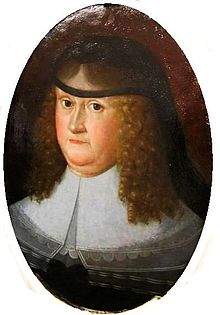Anna of Croÿ

Anna Duchess von Croÿ , born Duchess of Pomerania ; (* October 3, 1590 in Barth ; † July 7, 1660 in Stolp ) was the last member of the Griffin family and sister of the last Pomeranian duke.
Life
Anna of Pomerania was the youngest daughter of Duke Bogislaw XIII. and the Duchess Klara of Braunschweig-Lüneburg. She spent her childhood in Barth . After her mother's death, she lived temporarily in Stettin and in Güstrow with her aunt of the same name, Anna von Pommern, the wife of Ulrich Herzog zu Mecklenburg . When her father died in 1606, she was initially under the tutelage of her brother Philip II.
After 1612 she moved to live with her aunt Anna for a long time, who meanwhile lived on her widow's residence in Grabow . It was there that she met her future husband, Duke Ernst von Croÿ . In the marriage contract between the Catholic von Croÿ family and the evangelical griffins it was stipulated that the descendants of the two should be brought up in the spirit of Protestantism . For jointure Annaschloss were and domination Vinstingen determines where she moved with her husband to the wedding on August 4, 1619 in Szczecin. Ernst von Croÿ fell ill and died on October 7, 1620 in the field camp near Oppenheim , a few weeks after the birth of their son Ernst Bogislaw von Croÿ .
In Vinstingen the duchess came into conflict with the Catholic relatives of her late husband, who withheld her inheritance. After a stay in Strasbourg in 1622 she moved with her son to Stettin to her brother Bogislaw XIV. From this griffin duke she was equipped with the Stolp Castle and lands, including Ludwigsburg . However, she temporarily kept her residence in Szczecin until Bogislaw died. In Szczecin she was present at the conclusion of the inheritance contract between Bogislaw XIV and the Swedish King Gustav II Adolf .
After Bogislaw XIV died on March 10, 1637 as the last of her five brothers, Anna was the only surviving sister. She and her son inherited only his personal property, but not the duchy. The duchy was first taken by Sweden (see Swedish-Pomerania ) and later divided between Sweden and Brandenburg-Prussia . The outbreak of the Swedish-Polish War and the associated Polish attacks in Western Pomerania forced her to leave her retirement home in Stolp in 1656. At the beginning of November 1656 , she complained to the Electress Luise Henriette of Nassau-Oranien , the first wife of Elector Friedrich Wilhelm of Brandenburg . With the consent of the Great Elector, she lived in Rügenwalde and stayed temporarily in Stettin and Greifswald .
Memorial of the dead
Anna was buried in the castle church in Stolp . The grave monument commissioned by her son Ernst Bogislaw von Croÿ is still in the church today. Her magnificent sarcophagus is now in the Ducal Palace in an exhibition in the Central Pomeranian Museum, next to her son's magnificent sarcophagus.
Her son Ernst Bogislaw von Croÿ gave the University of Greifswald several pieces from the estate of the Pomeranian dukes. With the donation, he made the condition to hold a commemoration in honor of his mother and the Greifenhaus every 10 years, at which, among other things, the Croÿ carpet was to be presented. The celebration takes place regularly after an interruption from 1930 to 1992. However, the carpet is now in the permanent exhibition of the Pomeranian State Museum in Greifswald.
literature
- Adolf Häckermann : Croy, Anna von . In: Allgemeine Deutsche Biographie (ADB). Volume 4, Duncker & Humblot, Leipzig 1876, pp. 614-617.
Web links
- Literature about Anna von Croÿ in the state bibliography MV
- Anna, Princess of Pomerania-Szczecin
- From the academic art collection of the Ernst Moritz Arndt University with a portrait of Anna von Croy
Footnotes
- ^ Ernst Daniel Martin Kirchner: The electors and queens on the throne of the Hohenzollern , 2nd part: The last eight electors , Berlin 1867, pp. 278-279 .
- ^ Haik Thomas Porada: Finstingen an der Saar - On Pomeranian footsteps in Lorraine (Part II). In: Pomerania. Journal of Culture and History. Issue 1/2009, ISSN 0032-4167 , pp. 8-15.
| personal data | |
|---|---|
| SURNAME | Croÿ, Anna from |
| ALTERNATIVE NAMES | Anna of Pomerania; Anna from Croy |
| BRIEF DESCRIPTION | German nobles |
| DATE OF BIRTH | October 3, 1590 |
| PLACE OF BIRTH | Barth |
| DATE OF DEATH | July 7, 1660 |
| Place of death | Stumble |

